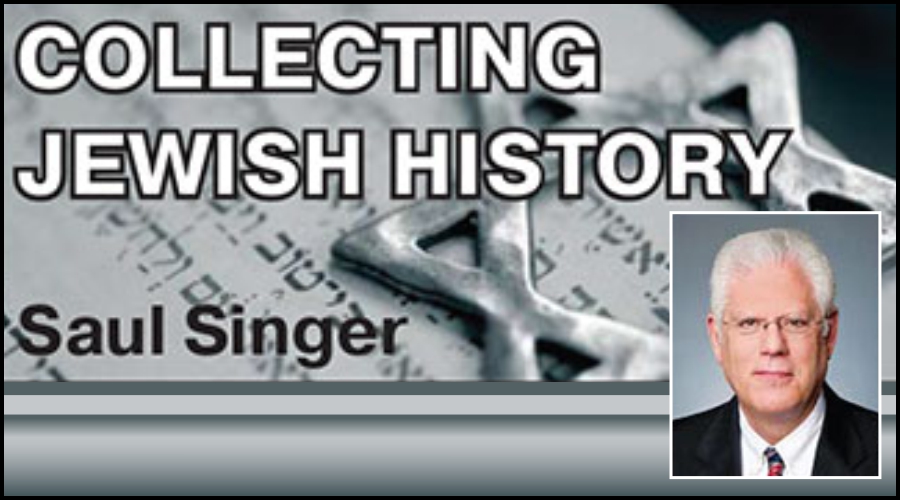The concept of the “Wandering Jew” derives from a popular literary legend about a Jew who, after mocking the Christian savior en route to being crucified on the cross, was condemned thereafter to a life of wandering the earth until Judgment Day.
The story of this wanderer was first recorded in the chronicles of Roger of Wendover and Matthew of Paris during the 13th century, and Nazi propaganda regularly cited the tale as proof that the persecution of the Jews by all races through the millennia was justified.

“Der Ewige Jude,” the German term for “the Wandering Jew” in medieval folklore, was also the name of the largest pre-war public anti-Semitic exhibit produced by the Nazis. The infamous emblematic image for the exhibit, which opened in the Library of the German Museum in Munich and ran from November 8, 1937 to January 31, 1938, featured an Eastern Jew in his black coat and sidelocks, as he holds gold coins in his right hand and a whip in his left hand. The red letters in Hebrew-like font symbolize the blood libel, and the map of Russia with the hammer and sickle that he carries links the Jews with communism. (See exhibit.)
Billed as a “degenerate art exhibit,” the enormously popular exhibition drew 412,300 visitors – over 5,000 per day – and the Propaganda Ministry followed it up with the publication of a book of the same title featuring 265 photographs, each with an offensive caption proclaiming the depravity, decadence, and corruption of the Jewish race.
The exhibition later moved to Vienna (August 2-October 23, 1938) and then to Berlin (November 12, 1938-January 31, 1939), and police reports showed a direct correlation between these events and a rise in anti-Semitic violence against the Jewish community in each city.
Shown here is an original “Der Ewige Jude” postcard depicting a long line of Germans waiting to enter the exhibit in Vienna. A Jew at the end of the line, portrayed with stereotypical anti-Semitism, says to an obviously irritated German: “The line may be long, but the frenzy is brief.” The cancellation, dated September 1, 1938, invites all to “visit the exhibition of Der Ewige Jude, Vienna.”

Kristallnacht (November 9-10, 1938), which was largely the initiative of Nazi Propaganda Minister Josef Goebbels, is broadly viewed as the official launching of Hitler’s Final Solution, but few people realize that, in fact, Kristallnacht was a dismal failure for the Nazis. It was an international political disaster for Hitler, but of far greater concern to him was the mixed reaction to Kristallnacht inside the German Fatherland, including media coverage reflecting a lack of broad support by the German people for the public violence.
A fuming Hitler reprimanded Goebbels for his open call to violence against the Jews and ordered him to implement propaganda programs that would lead the German people themselves to call for Jewish genocide. Goebbels’ first step was to order every film studio under German control to create an anti-Semitic film.
On October 24, 1939, he wrote in his diary, “Further rushes for our Jew film. The synagogue shots are extremely clear. At the moment, we are working to make a propaganda masterpiece out of all this.” That “Jew film masterpiece,” which was in production for over a year, became the film “Der Ewige Jude,” one of the most malevolent and odious pieces of propaganda of all time.
The film, shot in grainy and somber black-and-white, was specifically designed to infuse the German people with the image of Jews as sub-human creatures deserving elimination, thereby generating support for the implementation of the Final Solution. Directed by Fritz Hippler, president of the Reich Film Chamber, it opened on November 29, 1940 and was shown throughout Germany and Nazi-occupied Europe.
Goebbels sought to send crews to Poland to film the “Jewish vermin in their natural habitat,” but the Polish government denied them permission to do so. Almost immediately after the Nazi invasion of Poland, however, Goebbels sent camera crews to shoot in the Lodz, Warsaw, Krakow, and Lublin ghettos, and their footage constitutes the heart of the film.
Although Hippler promoted the film as a factual documentary, it was a blatant fraud and, at times, transparently and laughably inept. For example, the “authentic” synagogue scene praised by Goebbels in his diary was set up by Hippler and Goebbels at the Vilker synagogue, where they forced the Jews to don tallit and tefillin and conduct a full service, including reading the Torah; the film’s narrator, however, begins by announcing in a dramatic voice, “Today is Tuesday.” (Weekday Torah readings take place only on Monday and Thursday.)
The film also presents Rosa Luxemburg and Emma Goldman as the same person; Charlie Chaplin is misidentified as a Jew (though he did play a Jewish barber in “The Great Dictator,” which probably confused the filmmakers); and the stupidity goes on.
The theme of the Jews as insidious parasites preying on the body of an otherwise healthy host infuses the documentary in several forms, each designed to expose the “true” Jew beneath the veneer of European culture that concealed the Jewish bloodsucker.
“Der Ewige Jude” is notable for its highlighting the inherent “otherness” of East European Jews; thus, in one particular scene, “conventional” Polish Jews with beards are portrayed as clean-shaven gentlemen transformed into Western-looking Jews. The unmistakable message is that they can “dress up,” and they can try to “hide in plain sight” by trying to pass as ordinary Germans, but they are still Jewish vermin presenting a grave threat to Germany and the world.
Jews in the film appear as a foreign, swarthy, hook-nosed, untidily bearded, dour, hostile presence infiltrating the crowded streets of Europe. They haggle; they fight like animals over food at the table; they amass and hoard wealth, which they conceal from the tax collectors; they grow fat at the expense of the good German people; and their Jewish religion and culture are sources of secret powers, which they deploy against anyone who isn’t in their “club.”
In one infamous scene, swarms of disgusting rats scurry through cellars and sewers as the shots are intercut with images of Jews emigrating from Eretz Yisrael to all corners of the world. Close-ups of those Jews feature distorted and deformed facial features, as the voice-over explains that just as rats are the vermin of the animal kingdom, Jews are the vermin of the human race.
In another long and particularly infamous and bloody scene, shechitah is portrayed as monstrous, inhumane, and sadistic. An unidentified essayist, describing this scene in a Nazi journal, writes:
The most revolting scenes show Jewish slaughtering methods. These customs, which cast a particularly vivid spotlight on the so-called Jewish religion, are so terrible that it is hard to watch the film as the grinning Jewish butchers carry out their work. It is illuminating to see how stubbornly Jewry holds to its method of slaughter and with which casuistry it defends it against the horror of the civilized world.
The film blames Jews for dominating international crime; for “financial terrorism,” including controlling the world’s stock exchanges (and for also controlling culture, theater, film, publishing, press, radio, education, and politics); and for directly causing German inflation and unemployment as, consistent with their worship of mammon, they greedily and soullessly employ usury and racketeering against the German people.
Driving this point home, Hitler is shown in the film’s finale delivering his notorious January 30, 1939 speech to the Reichstag, in which he says: “If international Jewish financiers inside and outside Europe should succeed in plunging the nations once more into a world war, then the result will not be the Bolshevization of the earth and thus the victory of Jewry but the annihilation of the Jewish race in Europe.”
Exhibited here is a very rare NSDAP movie flyer for “Der Ewige Jude”; admission price is 50 DM for a hall seat, 60 RM for the balcony. Beneath the vulgar anti-Semitic caricature, the text reads:
A documentary about World Jewry
After an idea by: Dr. E. [Eberhard] Taubert
Layout: Fritz Hippler Music: F.R. Friedl
This film is unique because it is not fantasy, but an unpretentious, effective [portrayal of] wickedness.
This film is a valuable political and financial tool!
To the left of the image, the text explains: “This documentary film provides an insight into true Judaism, as it overwhelms thinking beyond imagination. The pictures were taken by the Jewish prisoners in Poland, and they took us into the gloomy ghettos, into the synagogue, and into their huts.”
Artistically, the film is considered a “black masterpiece” of the 1940 cinematic convention. However, the importance of “Der Ewige Jude” lies not in its technique but, rather, in its brutal service to the cause of anti-Semitism, as the film was expected to fill viewers with heartfelt gratitude for having a leader who, alone in world history, would be able to finally solve “the Jewish problem.” Films such as “Der Ewige Jude” helped prepare the German people to accept the eventual national policy of Jewish genocide and led inexorably to the Holocaust.
Unlike Kristallnacht, which was a propagandistic failure, “Der Ewige Jew” proved to be successful in inculcating the belief in the German people that the Jews – all of them – were dangerous predators who spread disease and corruption and needed to be exterminated.
The film, however, was a commercial failure; most screenings were by active members of the Nazi party and Nazi organizations, and it was actually better known through media coverage and by word-of-mouth descriptions than from paid admissions of people who saw it.
After Germany’s defeat in WWII, Hippler was tried for directing “Der Ewige Jude,” but, arguing that he played no role in killing Jews and that, in fact, it was Goebbels, working under Hitler’s close personal supervision, who was the true creator of the film, he was acquitted.
He later served the American military as a translator and, in an interview for the German documentary series “Holocaust” (2000), described the film as “the most disgraceful example of anti-Semitism.” This may be the only true statement by anyone associated with the film.
* * * * *
Irene Harand (1900-75) was an Austrian Christian human rights activist and campaigner who attacked Nazism, anti-Semitism, and religious intolerance, and effectively challenged Christians to live up to the teachings of their own religion with respect to the “Jewish question.” Because most Austrians felt a need to suppress painful details of their recent history, her story has only become somewhat known decades after the war ended, particularly after Israel bestowed upon her the most honorable title of a “Righteous Among the Nations” in 1969.

After witnessing Nazi Youth marching through Vienna and shouting “Death to the Jews!” to the total indifference of onlookers, Harand appeared at a Catholic political meeting to warn of the growing menace of Nazism, where she was scorned and taunted. When Hitler assumed control in Germany in 1933, she wrote and disseminated at her own cost a popular pamphlet that predicted that the Nazis would use anti-Semitism as a subterfuge to seize power in Austria – which, of course, they did.
From 1933 to 1938, she published the popular newspaper Gerechtigkeit (“Justice”), which was dedicated to educating the public about the threat of Nazism. The reaction was mixed, as some Austrians began to question some of their own prejudices while others called her a traitor and sent her death threats.
Harand next founded the Movement Against Anti-Semitism, Racial Hatred and Glorification of War, popularly known as the “Harand Movement,” in which capacity she, among other things, helped secure American visas for over 100 Jews to escape the Nazis.
Aware that her message of religious toleration and resistance to Nazi racism could only be effective if broadly disseminated, she showed remarkable creativity in “packaging” the movement’s ideas in many different forms, including a series of perforated gummed labels which, depicting great Jewish thinkers, artists, and scientists, countered the Nazi slander that Jews had never been cultural benefactors.
In 1937, intrepid Harand supporters entered the exhibition hall in Munich housing “Der Ewige Jude” and plastered the walls and display cases with many of these labels, which depicted, among other individuals, Jewish scientists Paul Ehrlich, Heinrich Hertz, and Emile Berliner; politicians Benjamin Disraeli and Walter Rathenau; and philosopher Baruch Spinoza, composer Giacomo Meyerbeer, and writer Heinrich Heine.
These labels, and her publication of Sein Kampf – an impassioned response to Hitler’s Mein Kampf – earned her a high place on the Nazis’ “most wanted” list, with a 100,000 Reichsmark bounty placed on her head in 1938. She escaped death only because she and her husband were in Great Britain lecturing at the time of the Anschluss, and the Harands immigrated to the United States in 1938, where Irene continued her activities until her death.




